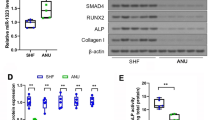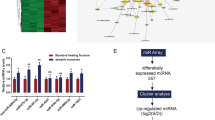Abstract
Nonunion is a serious complication after fracture due to its difficulty of self-healing. MicroRNA-26a (miR-26a) has been known to play a crucial role in bone metabolism. In this study, we established a rat nonunion model by removing periosteum, and found that miR-26a was significantly upregulated. Osteogenic differentiation of mesenchymal stem cells (MSCs) isolated from bone marrow transfected with miR-26a mimics was significantly enhanced, evidenced by increased calcium deposition and expression levels of alkaline phosphatase (ALP) and osteocalcin. Bioinformatics analysis suggested that sclerostin domain-containing 1 (SOSTDC1) may be a target of miR-26a, which was confirmed by dual-luciferase assay and western blot. Besides, miR-26a was used for nonunion rats. Delightfully, radiographs of nonunion rats with miR-26a mimics administration showed obvious new bone formation compared with nonhealing control. Hematoxylin–eosin and Masson staining assays revealed that osteogenesis capacity was greatly enhanced by miR-26a mimics’ administration. In addition, miR-26a mimics could promote osteogenic differentiation in nonunion rats, evidenced by increased protein levels of ALP and osteocalcin, while SOSTDC1 was suppressed. The injection of miR-26a mimics also gave rise to phosphorylation of GSK3β and nuclear accumulation of β-catenin, which indicated the activation of canonical Wnt/β-catenin signaling. In conclusion, we demonstrated that miR-26a promoted fracture healing of rats with nonunion in vivo and osteogenic differentiation of MSCs in vitro, possibly by targeting SOSTDC1, and that Wnt/β-catenin signaling pathway was involved in this process.




Similar content being viewed by others
References
Leighton R, Watson JT, Giannoudis P, Papakostidis C, Harrison A, Steen RG (2017) Healing of fracture nonunions treated with low-intensity pulsed ultrasound (LIPUS): a systematic review and meta-analysis. Injury 48:1339–1347. https://doi.org/10.1016/j.injury.2017.05.016
Buza JA 3rd, Einhorn T (2016) Bone healing in 2016. Clin Cases Miner Bone Metab 13:101–105. https://doi.org/10.11138/ccmbm/2016.13.2.101
Yu J, Xu L, Li K, Xie N, Xi Y, Wang Y, Zheng X, Chen X, Wang M, Ye X (2017) Zinc-modified calcium silicate coatings promote osteogenic differentiation through TGF-beta/Smad pathway and osseointegration in osteopenic rabbits. Sci Rep 7:3440. https://doi.org/10.1038/s41598-017-03661-5
Secreto FJ, Hoeppner LH, Westendorf JJ (2009) Wnt signaling during fracture repair. Curr Osteoporos Rep 7:64–69
Mohr AM, Mott JL (2015) Overview of microRNA biology. Semin Liver Dis 35:3–11. https://doi.org/10.1055/s-0034-1397344
Brennecke J, Hipfner DR, Stark A, Russell RB, Cohen SM (2003) bantam encodes a developmentally regulated microRNA that controls cell proliferation and regulates the proapoptotic gene hid in Drosophila. Cell 113:25–36
Naguibneva I, Ameyar-Zazoua M, Polesskaya A, Ait-Si-Ali S, Groisman R, Souidi M, Cuvellier S, Harel-Bellan A (2006) The microRNA miR-181 targets the homeobox protein Hox-A11 during mammalian myoblast differentiation. Nat Cell Biol 8:278–284. https://doi.org/10.1038/ncb1373
Shenouda SK, Alahari SK (2009) MicroRNA function in cancer: oncogene or a tumor suppressor? Cancer Metastasis Rev 28:369–378. https://doi.org/10.1007/s10555-009-9188-5
Liu XX, Li XJ, Zhang B, Liang YJ, Zhou CX, Cao DX, He M, Chen GQ, He JR, Zhao Q (2011) MicroRNA-26b is underexpressed in human breast cancer and induces cell apoptosis by targeting SLC7A11. FEBS Lett 585:1363–1367. https://doi.org/10.1016/j.febslet.2011.04.018
Ji J, Shi J, Budhu A, Yu Z, Forgues M, Roessler S, Ambs S, Chen Y, Meltzer PS, Croce CM, Qin LX, Man K, Lo CM, Lee J, Ng IO, Fan J, Tang ZY, Sun HC, Wang XW (2009) MicroRNA expression, survival, and response to interferon in liver cancer. N Engl J Med 361:1437–1447. https://doi.org/10.1056/NEJMoa0901282
Gao W, Shen H, Liu L, Xu J, Shu Y (2011) MiR-21 overexpression in human primary squamous cell lung carcinoma is associated with poor patient prognosis. J Cancer Res Clin Oncol 137:557–566. https://doi.org/10.1007/s00432-010-0918-4
Trompeter HI, Dreesen J, Hermann E, Iwaniuk KM, Hafner M, Renwick N, Tuschl T, Wernet P (2013) MicroRNAs miR-26a, miR-26b, and miR-29b accelerate osteogenic differentiation of unrestricted somatic stem cells from human cord blood. BMC Genomics 14:111. https://doi.org/10.1186/1471-2164-14-111
Li Y, Fan L, Hu J, Zhang L, Liao L, Liu S, Wu D, Yang P, Shen L, Chen J, Jin Y (2015) MiR-26a rescues bone regeneration deficiency of mesenchymal stem cells derived from osteoporotic mice. Mol Ther 23:1349–1357. https://doi.org/10.1038/mt.2015.101
Collette NM, Yee CS, Hum NR, Murugesh DK, Christiansen BA, Xie L, Economides AN, Manilay JO, Robling AG, Loots GG (2016) Sostdc1 deficiency accelerates fracture healing by promoting the expansion of periosteal mesenchymal stem cells. Bone 88:20–30. https://doi.org/10.1016/j.bone.2016.04.005
Kiso H, Takahashi K, Saito K, Togo Y, Tsukamoto H, Huang B, Sugai M, Shimizu A, Tabata Y, Economides AN, Slavkin HC, Bessho K (2014) Interactions between BMP-7 and USAG-1 (uterine sensitization-associated gene-1) regulate supernumerary organ formations. PLoS ONE 9:e96938. https://doi.org/10.1371/journal.pone.0096938
Cho SW, Kwak S, Woolley TE, Lee MJ, Kim EJ, Baker RE, Kim HJ, Shin JS, Tickle C, Maini PK, Jung HS (2011) Interactions between Shh, Sostdc1 and Wnt signaling and a new feedback loop for spatial patterning of the teeth. Development 138:1807–1816. https://doi.org/10.1242/dev.056051
Yoshizuka M, Nakasa T, Kawanishi Y, Hachisuka S, Furuta T, Miyaki S, Adachi N, Ochi M (2016) Inhibition of microRNA-222 expression accelerates bone healing with enhancement of osteogenesis, chondrogenesis, and angiogenesis in a rat refractory fracture model. J Orthop Sci 21:852–858. https://doi.org/10.1016/j.jos.2016.07.021
Gomez-Barrena E, Rosset P, Lozano D, Stanovici J, Ermthaller C, Gerbhard F (2015) Bone fracture healing: cell therapy in delayed unions and nonunions. Bone 70:93–101. https://doi.org/10.1016/j.bone.2014.07.033
Kostenuik P, Mirza FM (2017) Fracture healing physiology and the quest for therapies for delayed healing and nonunion. J Orthop Res 35:213–223. https://doi.org/10.1002/jor.23460
Hong E, Reddi AH (2012) MicroRNAs in chondrogenesis, articular cartilage, and osteoarthritis: implications for tissue engineering. Tissue Eng Part B Rev 18:445–453. https://doi.org/10.1089/ten.TEB.2012.0116
Waki T, Lee SY, Niikura T, Iwakura T, Dogaki Y, Okumachi E, Oe K, Kuroda R, Kurosaka M (2016) Profiling microRNA expression during fracture healing. BMC Musculoskelet Disord 17:83. https://doi.org/10.1186/s12891-016-0931-0
Leeper NJ, Raiesdana A, Kojima Y, Chun HJ, Azuma J, Maegdefessel L, Kundu RK, Quertermous T, Tsao PS, Spin JM (2011) MicroRNA-26a is a novel regulator of vascular smooth muscle cell function. J Cell Physiol 226:1035–1043. https://doi.org/10.1002/jcp.22422
Kota J, Chivukula RR, O’Donnell KA, Wentzel EA, Montgomery CL, Hwang HW, Chang TC, Vivekanandan P, Torbenson M, Clark KR, Mendell JR, Mendell JT (2009) Therapeutic microRNA delivery suppresses tumorigenesis in a murine liver cancer model. Cell 137:1005–1017. https://doi.org/10.1016/j.cell.2009.04.021
Su X, Liao L, Shuai Y, Jing H, Liu S, Zhou H, Liu Y, Jin Y (2015) MiR-26a functions oppositely in osteogenic differentiation of BMSCs and ADSCs depending on distinct activation and roles of Wnt and BMP signaling pathway. Cell Death Dis 6:e1851. https://doi.org/10.1038/cddis.2015.221
Lin G, Liu B, Meng Z, Liu Y, Li X, Wu X, Zhou Q, Xu K (2017) MiR-26a enhances invasive capacity by suppressing GSK3beta in human lung cancer cells. Exp Cell Res 352:364–374. https://doi.org/10.1016/j.yexcr.2017.02.033
Paquet J, Moya A, Bensidhoum M, Petite H (2016) Engineered cell-free scaffold with two-stage delivery of miRNA-26a for bone repair. Ann Transl Med 4:204. https://doi.org/10.21037/atm.2016.05.28
Acknowledgements
This study was supported by grants from the Projects of Department of Science and Technology, Shaanxi Province (Nos. 2012JM4046 and 2013K14-02-12).
Author information
Authors and Affiliations
Corresponding author
Ethics declarations
Conflict of interest
The authors declare that they have no conflicts of interest.
Additional information
Publisher's Note
Springer Nature remains neutral with regard to jurisdictional claims in published maps and institutional affiliations.
Rights and permissions
About this article
Cite this article
Sun, L., Li, Z., Xue, H. et al. MiR-26a promotes fracture healing of nonunion rats possibly by targeting SOSTDC1 and further activating Wnt/β-catenin signaling pathway. Mol Cell Biochem 460, 165–173 (2019). https://doi.org/10.1007/s11010-019-03578-9
Received:
Accepted:
Published:
Issue Date:
DOI: https://doi.org/10.1007/s11010-019-03578-9




